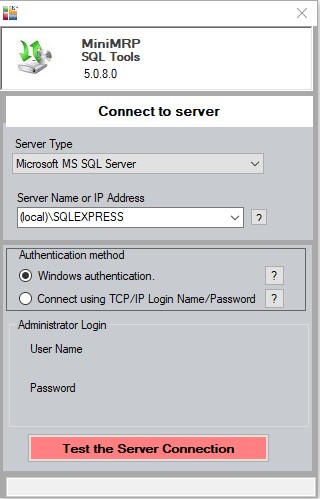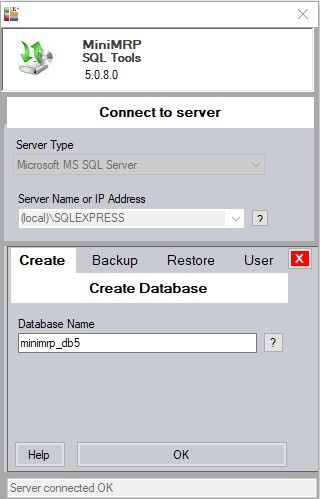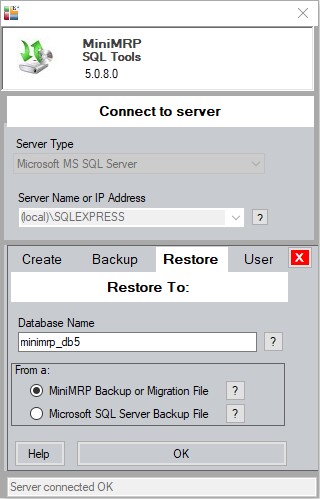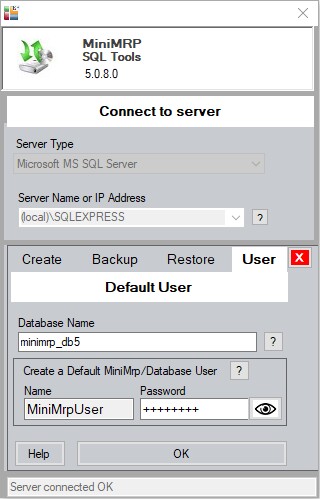SQL Tools for MiniMRP.
This page assumes that you have a Microsoft SQL Server and that you have the necessary SQL Server permission to create and administer databases on the server. If you do not then you need to install SQL Server or have your IT department install it for you. Installing Microsoft's SQL Server is not a trivial matter but we've created some screenshots which may give you some guidance. Install SQL Server
Restore/Migrate a database from a previous version of MiniMRP (or create a new one)
The main MiniMRP program can connect to SQL Server but it does not contain the tools necessary to create or restore SQL Server databases. We've done it that way so that remote or less experienced users of MiniMRP can not accidentally delete or restore a database on a Server. For that purpose we have a separate tool which you, as the system administrator, may wish to delete from users' computer after installation.
MiniMRP usually installs in the folder
C:/Program Files(x86)/MiniMrp5
Look in that folder and see the /Tools/ sub folder. In the Tools folder is the program DBTools
If you have a network shared SQL Server machine then MiniMRP does not need to be installed on the SQL Server machine. But if possible we'd recommend making a copy of DBTools, maybe on a USB/thumb drive, and run it while sat the at the SQL Server machine. It is often easier to connect and administer SQL Server if you're physically sat at that machine. But if that's not possible you should still be able to connect to the server provided you have the necessary SQL Server credentials.
Start the DBTools program. Be sure DBTools is version 5 or above.

Select: Server Type "Microsoft SQL Server"
Select or enter Server Name or IP Address. In our example we are running the DBTools program on the same machine where SQL Server is running and DB Tools will usually detect instances of SQL Server that are running on this machine and the 'drop-down' list should contains names of found instances allowing you to select the server name.
Select Authentication method. Assuming DBTools is running on the same machine as SQL Server the 'Windows Authentication' method is most likely to work and we don't need to enter username/password to connect. Depending on your network setup and/or if you're connecting remotely to your server you may need to select the TCP/IP option and enter the Server Name or IP address instead.
Click the button to 'test Server Connection'. If connection is successful the display changes to show additional options. (see image below)

If you are preparing a new installation of MiniMRP and you have no previous data then you can select the 'Create' option and click the OK button to create a new empty database.
In any case we would suggest that you accept the default Database Name 'minimrp_db5'. There's no technical reason for this it's just the database name that we'll refer to or show in other help pages.
Restoring from a backup or previous version of MiniMRP.
If you are migrating from a previous version of MiniMRP or migrating from a standard/non-sql database to a professional edition on MSSQL Server then select the "Restore" option.

If you select "Restore" and click OK you'll be able to navigate to a MiniMRP backup file or even select a v3 (emrp.axi) or a v4 (mrp4data) or a v5 (mrp5data) database file. The MiniMrp data will be imported into a new v5 database on SQL Server.
Migration from a local backup file up to the server is quite a big process so if your database is very big, ie many 1000's of items, orders etc, then the migration may take a few minutes. The data is copied to a temp file before restoring/migrating so the original data file is not changed in any way so previous versions of Minimrp won't be affected.
Note: If you do not have any previous version and this is a brand new installation of MiniMRP then instead of the 'Restore' option you can select the 'Create' to create a new empty database on your server.
Creating a MiniMRP User.
This step creates a default account on the database server with minimal set of permissions to run MiniMRP across your network.
If you'd rather use other admin tools such as Microsoft SQL Server Management Studio (SSMS) to create and manage your sql server user accounts you should use your chosen tool to create at least one user account with permission to connect from other computers with reader/writer permissions on the MiniMRP database. Then skip ahead to start MiniMRP.
Assuming you want to create the default user with default permissions for MiniMRP Click the "User" tab.

Enter a password - the characters are obscured - Click the 'eye' button to see/confirm if necessary. Click the 'OK' button to create the user account. If the account already exists it will be replaced with the new one with the new password (You could use this to change your default user password regularly if you wished)
Note: Even if you have a few users they can all use this one sql user account so you only need to do this once. But, as mentioned above, you can always use SSMS to create/administer more user accounts if you wish.
See next page - Setting up MiniMRP to connect to SQL Server
